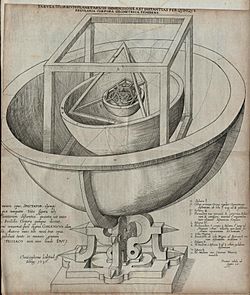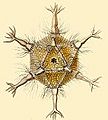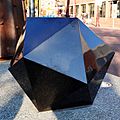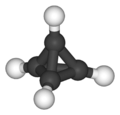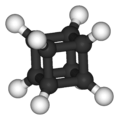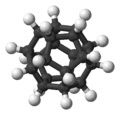Platonic solid facts for kids
- The Platonic Solids
A platonic solid is a three dimensional shape. It has the following characteristics:
- Each face is built from the same type of polygons
- There are the same number of polygons meeting at every corner of the shape.
The platonic solids
The following Platonic solids exist; there are only 5:
- Tetrahedron, has 4 sides, is made of triangles, and looks like a pyramid.
- Cube, Hexahedron, has 6 sides, and is made of squares.
- Octahedron, has 8 sides, and is made of triangles.
- Dodecahedron, has 12 sides, and is made of pentagons.
- Icosahedron, has 20 sides, and is made of triangles.
History
The Platonic solids have been known since antiquity. It has been suggested that certain carved stone balls created by the late Neolithic people of Scotland represent these shapes; however, these balls have rounded knobs rather than being polyhedral, the numbers of knobs frequently differed from the numbers of vertices of the Platonic solids, there is no ball whose knobs match the 20 vertices of the dodecahedron, and the arrangement of the knobs was not always symmetric.
The ancient Greeks studied the Platonic solids extensively. Some sources (such as Proclus) credit Pythagoras with their discovery. Other evidence suggests that he may have only been familiar with the tetrahedron, cube, and dodecahedron and that the discovery of the octahedron and icosahedron belong to Theaetetus, a contemporary of Plato. In any case, Theaetetus gave a mathematical description of all five and may have been responsible for the first known proof that no other convex regular polyhedra exist.
The Platonic solids are prominent in the philosophy of Plato, their namesake. Plato wrote about them in the dialogue Timaeus c.360 B.C. in which he associated each of the four classical elements (earth, air, water, and fire) with a regular solid. Earth was associated with the cube, air with the octahedron, water with the icosahedron, and fire with the tetrahedron. There was intuitive justification for these associations: the heat of fire feels sharp and stabbing (like little tetrahedra). Air is made of the octahedron; its minuscule components are so smooth that one can barely feel it. Water, the icosahedron, flows out of one's hand when picked up, as if it is made of tiny little balls. By contrast, a highly nonspherical solid, the hexahedron (cube) represents "earth". These clumsy little solids cause dirt to crumble and break when picked up in stark difference to the smooth flow of water. Moreover, the cube's being the only regular solid that tessellates Euclidean space was believed to cause the solidity of the Earth.
Of the fifth Platonic solid, the dodecahedron, Plato obscurely remarked, "...the god used [it] for arranging the constellations on the whole heaven". Aristotle added a fifth element, aithēr (aether in Latin, "ether" in English) and postulated that the heavens were made of this element, but he had no interest in matching it with Plato's fifth solid.
Euclid completely mathematically described the Platonic solids in the Elements, the last book (Book XIII) of which is devoted to their properties. Propositions 13–17 in Book XIII describe the construction of the tetrahedron, octahedron, cube, icosahedron, and dodecahedron in that order. For each solid Euclid finds the ratio of the diameter of the circumscribed sphere to the edge length. In Proposition 18 he argues that there are no further convex regular polyhedra. Andreas Speiser has advocated the view that the construction of the 5 regular solids is the chief goal of the deductive system canonized in the Elements. Much of the information in Book XIII is probably derived from the work of Theaetetus.
In the 16th century, the German astronomer Johannes Kepler attempted to relate the five extraterrestrial planets known at that time to the five Platonic solids. In Mysterium Cosmographicum, published in 1596, Kepler proposed a model of the Solar System in which the five solids were set inside one another and separated by a series of inscribed and circumscribed spheres. Kepler proposed that the distance relationships between the six planets known at that time could be understood in terms of the five Platonic solids enclosed within a sphere that represented the orbit of Saturn. The six spheres each corresponded to one of the planets (Mercury, Venus, Earth, Mars, Jupiter, and Saturn). The solids were ordered with the innermost being the octahedron, followed by the icosahedron, dodecahedron, tetrahedron, and finally the cube, thereby dictating the structure of the solar system and the distance relationships between the planets by the Platonic solids. In the end, Kepler's original idea had to be abandoned, but out of his research came his three laws of orbital dynamics, the first of which was that the orbits of planets are ellipses rather than circles, changing the course of physics and astronomy. He also discovered the Kepler solids, which are two nonconvex regular polyhedra.
Uses
The shapes are often used to make dice, because dice of these shapes can be made fair. 6-sided dice are very common, but the other numbers are commonly used in role-playing games. Such dice are commonly referred to as D followed by the number of faces (d8, d20 etc.).
The tetrahedron (4 sided), cube (6 sided), and octahedron (8 sided), are found naturally in crystal structures. The dodecahedron (12 sides) is combinatorially identical to the pyritohedron (in that both have twelve pentagonal faces), which is one of the possible crystal structures of pyrite. However, the pyritohedron is not a regular dodecahedron, but rather has the same symmetry as the cube.
In meteorology and climatology, global numerical models of atmospheric flow are of increasing interest which use grids that are based on an icosahedron (20 sides,refined by triangulation) instead of the more commonly used longitude/latitude grid. This has the advantage of better spatial resolution without singularities (i.e. the poles) at the expense of somewhat greater numerical difficulty.
Geometry of space frames is often based on platonic solids.
Images for kids
-
Circogonia icosahedra, a species of radiolaria, shaped like a regular icosahedron.
See also
 In Spanish: Sólidos platónicos para niños
In Spanish: Sólidos platónicos para niños







